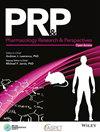Pharmacokinetics, disposition, and biotransformation of the cardiac myosin inhibitor aficamten in humans
IF 2.9
4区 医学
Q2 PHARMACOLOGY & PHARMACY
引用次数: 0
Abstract
Aficamten, a cardiac myosin inhibitor, is being developed for the treatment of patients with symptomatic hypertrophic cardiomyopathy (HCM). The purpose of this study was to determine the absorption, metabolism, and excretion of aficamten. Eight healthy male participants received a single oral dose of 20 mg aficamten (containing approximately 100 μCi of radiocarbon). Blood, urine, and feces samples were collected up to a maximum of Day 26. The pharmacokinetics of aficamten were characterized by moderate absorption, with a median t心肌酶抑制剂阿非坎顿在人体内的药代动力学、处置和生物转化
阿菲康坦是一种心肌肌球蛋白抑制剂,目前正在开发用于治疗症状性肥厚型心肌病(HCM)患者。本研究的目的是确定阿菲康坦的吸收、代谢和排泄情况。八名健康男性参加者单次口服了 20 毫克阿非坎顿(约含 100 μCi 放射性碳)。采集的血液、尿液和粪便样本最多可持续到第 26 天。阿非卡姆登的药代动力学特点是吸收适中,中位 tmax 为服药后 2.0 小时。阿非卡姆登的中位 t1/2 为 99.6 小时,血浆和全血中的代谢物和总放射性的 t1/2 与之相似。给药总放射性的总回收率为 89.7%,其中 57.7% 的剂量从粪便中回收,32.0% 从尿液中回收。血浆中的主要循环代谢物包括单羟化代谢物 M1a(CK-3834282)和 M1b(CK-3834283),分别占总放射性 AUC 的 10.5%和 36.4%,中位 tmax 均为 5 小时。在尿液中,M5是含量最高的代谢物,占总放射性剂量(TRD)的8.02%,其次是M1a和M1b,分别占TRD的6.16%和2.85%;然而,在尿液中没有观察到剂量达到>10%的代谢物。粪便中的主要代谢物是 M18,占放射性剂量的 44.1%。这些研究结果表明,阿非卡姆登是通过新陈代谢排出体外的,少量未改变的阿非卡姆登通过粪便排出体外,肾脏排泄起次要作用。粪便是放射性剂量的主要排泄途径。
本文章由计算机程序翻译,如有差异,请以英文原文为准。
求助全文
约1分钟内获得全文
求助全文
来源期刊

Pharmacology Research & Perspectives
Pharmacology, Toxicology and Pharmaceutics-General Pharmacology, Toxicology and Pharmaceutics
CiteScore
5.30
自引率
3.80%
发文量
120
审稿时长
20 weeks
期刊介绍:
PR&P is jointly published by the American Society for Pharmacology and Experimental Therapeutics (ASPET), the British Pharmacological Society (BPS), and Wiley. PR&P is a bi-monthly open access journal that publishes a range of article types, including: target validation (preclinical papers that show a hypothesis is incorrect or papers on drugs that have failed in early clinical development); drug discovery reviews (strategy, hypotheses, and data resulting in a successful therapeutic drug); frontiers in translational medicine (drug and target validation for an unmet therapeutic need); pharmacological hypotheses (reviews that are oriented to inform a novel hypothesis); and replication studies (work that refutes key findings [failed replication] and work that validates key findings). PR&P publishes papers submitted directly to the journal and those referred from the journals of ASPET and the BPS
 求助内容:
求助内容: 应助结果提醒方式:
应助结果提醒方式:


